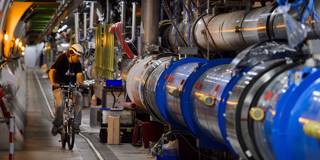Physics has changed, but the methods of particle physicists have not: they still rely on serendipitous discoveries. That works when exploratory experiments are diverse and numerous. But when new experiments cost billions of dollars and take decades to prepare and conduct, it is far from the best approach.
FRANKFURT – Between Lake Geneva and the Swiss Jura, more than 100 meters (328 feet) below the surface, lies a circular tunnel, 27 kilometers (17 miles) in circumference, containing superconducting magnets that accelerate protons almost to the speed of light. At four locations in the tunnel, the protons are made to collide. Particle physicists observe these collisions, in an effort to learn what matter is made of and what holds it together.

FRANKFURT – Between Lake Geneva and the Swiss Jura, more than 100 meters (328 feet) below the surface, lies a circular tunnel, 27 kilometers (17 miles) in circumference, containing superconducting magnets that accelerate protons almost to the speed of light. At four locations in the tunnel, the protons are made to collide. Particle physicists observe these collisions, in an effort to learn what matter is made of and what holds it together.